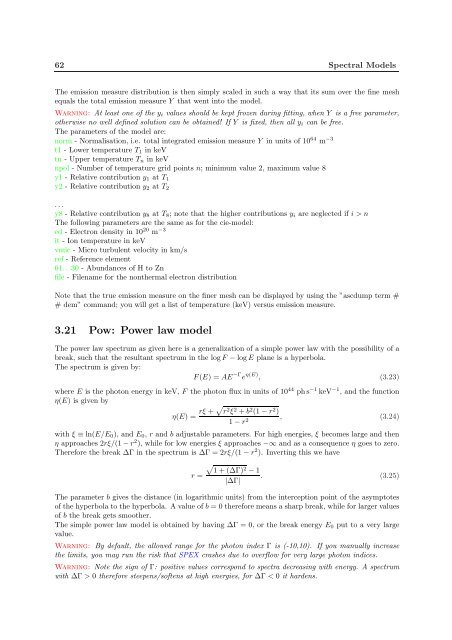SPEX User's Manual - SRON
SPEX User's Manual - SRON
SPEX User's Manual - SRON
You also want an ePaper? Increase the reach of your titles
YUMPU automatically turns print PDFs into web optimized ePapers that Google loves.
62 Spectral Models<br />
The emission measure distribution is then simply scaled in such a way that its sum over the fine mesh<br />
equals the total emission measure Y that went into the model.<br />
Warning: At least one of the y i values should be kept frozen during fitting, when Y is a free parameter,<br />
otherwise no well defined solution can be obtained! If Y is fixed, then all y i can be free.<br />
The parameters of the model are:<br />
norm - Normalisation, i.e. total integrated emission measure Y in units of 10 64 m −3<br />
t1 - Lower temperature T 1 in keV<br />
tn - Upper temperature T n in keV<br />
npol - Number of temperature grid points n; minimum value 2, maximum value 8<br />
y1 - Relative contribution y 1 at T 1<br />
y2 - Relative contribution y 2 at T 2<br />
. . .<br />
y8 - Relative contribution y 8 at T 8 ; note that the higher contributions y i are neglected if i > n<br />
The following parameters are the same as for the cie-model:<br />
ed - Electron density in 10 20 m −3<br />
it - Ion temperature in keV<br />
vmic - Micro turbulent velocity in km/s<br />
ref - Reference element<br />
01. . .30 - Abundances of H to Zn<br />
file - Filename for the nonthermal electron distribution<br />
Note that the true emission measure on the finer mesh can be displayed by using the ”ascdump term #<br />
# dem” command; you will get a list of temperature (keV) versus emission measure.<br />
3.21 Pow: Power law model<br />
The power law spectrum as given here is a generalization of a simple power law with the possibility of a<br />
break, such that the resultant spectrum in the log F − log E plane is a hyperbola.<br />
The spectrum is given by:<br />
F(E) = AE −Γ e η(E) , (3.23)<br />
where E is the photon energy in keV, F the photon flux in units of 10 44 ph s −1 keV −1 , and the function<br />
η(E) is given by<br />
η(E) = rξ + √ r 2 ξ 2 + b 2 (1 − r 2 )<br />
1 − r 2 , (3.24)<br />
with ξ ≡ ln(E/E 0 ), and E 0 , r and b adjustable parameters. For high energies, ξ becomes large and then<br />
η approaches 2rξ/(1 − r 2 ), while for low energies ξ approaches −∞ and as a consequence η goes to zero.<br />
Therefore the break ∆Γ in the spectrum is ∆Γ = 2rξ/(1 − r 2 ). Inverting this we have<br />
r =<br />
√<br />
1 + (∆Γ)2 − 1<br />
. (3.25)<br />
|∆Γ|<br />
The parameter b gives the distance (in logarithmic units) from the interception point of the asymptotes<br />
of the hyperbola to the hyperbola. A value of b = 0 therefore means a sharp break, while for larger values<br />
of b the break gets smoother.<br />
The simple power law model is obtained by having ∆Γ = 0, or the break energy E 0 put to a very large<br />
value.<br />
Warning: By default, the allowed range for the photon index Γ is (-10,10). If you manually increase<br />
the limits, you may run the risk that <strong>SPEX</strong> crashes due to overflow for very large photon indices.<br />
Warning: Note the sign of Γ: positive values correspond to spectra decreasing with energy. A spectrum<br />
with ∆Γ > 0 therefore steepens/softens at high energies, for ∆Γ < 0 it hardens.

















